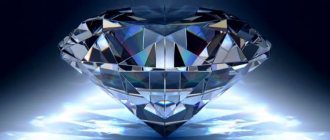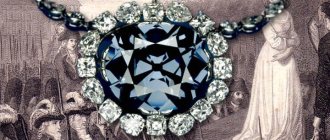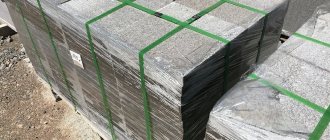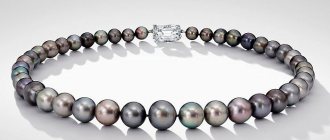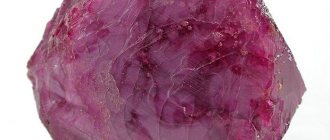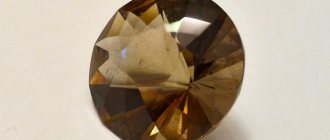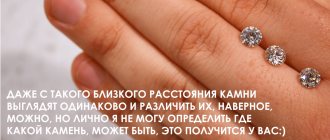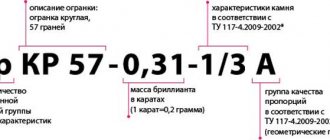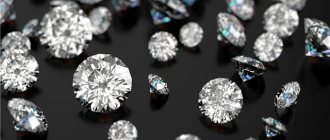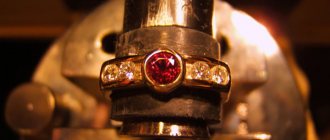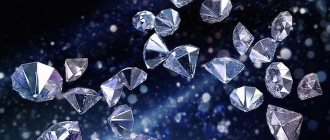Why diamonds?
As they say, a girl's best friend is diamonds . They are bright, beautiful, attract attention and are very popular with the female half of humanity. Every woman probably wants to receive a diamond ring as a gift. It will sparkle very beautifully on your finger, uplifting your mood. When choosing diamond jewelry, you always need to pay attention to many details.
Type classification of cut and diamond structure
A diamond is characterized by its cut and appearance. If you look at the stone from above, the geometric outline will show the view. The location designation and the difference between the edges determine the cut. The introduction of new technologies and creative searches by jewelers give birth to new types of cutting. All of them are subject to the laws by which the stone is ground.
The structure of the crystal and its weight influence the choice of type and cut. Processed diamonds are characterized by clear parameters. The markings of the diamond are perfectly aligned. A properly cut diamond, regardless of type, consists of three parts:
- The crown is the upper part that defines the look. A reflection of light is visible through it. Consists of a flat surface called a platform, to which are adjacent the main faces of the top, single star facet wedges, and a number of paired top wedges.
- Girdle - a strip that separates the lower part from the upper. Such processing is appreciated in which the girdle looks like a thin light line. This is the supporting part that is usually attached to the decoration. The quality of this belt is characterized by the skill of the cutter. When examined under a magnifying glass, it looks rough and matte. Sometimes it is polished, but complete transparency and smoothness will reveal a fake.
- Pavilion - the lower pointed tenon, consists of a facet of the bottom and a series of wedge-shaped edges of the bottom. Kalette is the lowest point where the edges meet. The standard for the tenon is 43.4% of the diameter of the diamond. If the pavilion is short or too elongated, the light flux is not reflected from the lower edges. The radiant mystical shine for which the decoration is valued is lost.
Jewelers use all kinds of cuts or combinations of them to inlay jewelry.
Marquise cut
“Round” or classic cut with 17 and 57 facets
This is the most commonly used type of cut. Up to 90% of diamonds are cut with it. Suitable for all sizes of original diamond. Jewelers claim that with this treatment, the beam entering through the upper platform is ideally transformed, and the lower edges reflect the beam in the best way. A unique diamond reflection is created, including the entire spectrum of rainbow shades.
The number of facets also depends on the weight, which is measured in carats. One carat weighs 0.02 grams. Thus, gemstones up to 0.03 carats are processed into 17 facets; from 0.03 to 0.05 carats – by 33; A diamond of 1 carat or more receives a classic cut consisting of 57 facets.
Large diamonds are sharpened to 73, 86 is the “royal cut”, and the largest ones, called “majestic radiance”, are sharpened to 102.
"Oval" cut
The name characterizes the type of site. The classic Oval diamond cut has been around for over six decades. The elongated shape is given by wedges elongated on two opposite sides; it has a 57-carat diamond. Decoration with an “Oval” crystal will especially emphasize the grace of the hand.
Princess cut
"Fancy" cut and its types
The characteristics of the crystal structure influence the choice of the “Fancy” cut. Diamonds with this treatment are conventionally divided into three groups:
- Modified, or wedge, cutting of diamonds into brilliants is more common than others. A new form is created based on the existing one. The number and position of edges remain unchanged. In terms of reflection, they look like round decorations. This type includes “Marquis”, “Pear”, “Heart”, “Cushion”.
- Step processing is applied to square, rectangular, trapezoidal types of stones. The edges along the girdle emphasize color and transparency. “Emerald” and “Baguette” are examples of such turning.
- The mixed cut combines the advantages of the first two types: step - for maximum weight retention and crown - for revealing light-refracting properties. The classic crown was first combined with a stepped pavilion more than sixty years ago.
Princess cut
“Princess” is a decoration of a square, less often rectangular, type with sharp corners. The second most common species. Not inferior to “Round” in brilliance. When cutting, there is less material loss. Meets high requirements for a diamond. It first appeared in the mid-twentieth century. Wedding rings and rings are often decorated with this type of gemstone. Used for inlaying crowns and geometrically correct products.
Important! When choosing a decoration of the “Princess” type, pay attention to the protection of sharp corners, the weak point of this shape.
Marquise cut
Its origin is told by a beautiful legend that Louis XV gave his favorite Marquise de Pompadour a luxurious diamond reminiscent of her smile. Hence the name "Marquis" is borrowed. The appearance is oblong with pointed ends in the shape of a “boat”. Sometimes they are called "Cat's Eye" or "Shuttle". Looks great when paired with a small crystal headband. Diamonds of this type are used to decorate brooches, bracelets and other jewelry pieces.
It is important to remember that the Marquise decoration should be handled carefully: its wedge-shaped ends are thin and very fragile.
Heart cut
Radiant cut
The romantic symbol of love is embodied in jewelry. The first mention of a heart-shaped diamond dates back to 1463 and is associated with the name of the Duke of Milan. There is evidence of Queen Mary Stuart's gift to Elizabeth I of a heart-shaped ring with a crystal. The modified “Pear” with a notch at the top has an octagonal platform, 57 or 58 sides and plays beautifully in the rays of light. To maintain strength, the width and length are in a 1:1 ratio, which reduces the risk of damage to the decoration.
Radiant and Asscher cut
The “Radiant” gem was first demonstrated in Amsterdam in the seventies of the last century and became widespread. It has the shape of a rectangle or square with beveled corners. Typically made with 61 or 77 edges. Refers to the stepped type. The cut was obtained by combining “Princess” and “Emerald”. The absence of sharp corners increases strength and allows the stone to be better secured in the setting. The unique arrangement of the facets enhances the color and is therefore particularly suitable for tinted diamonds.
"Asher" is a modified "Emerald". A square platform with beveled corners is bordered by three steps of cutting the crown into 49, 57 or 75 facets. The ground edges of the chamfers create a diagonal cross shape. This is its main feature. Developed about 120 years ago by the Usher brothers.
Rose cut
Rose cut flower shape
The first known cut to resemble rose petals. Widely used until the seventeenth century. The peculiarity is that the edges are located only on the crown, and the pavilion is either absent or smoothly ground. The classic “rose” has 24 sides. Currently used for processing diamonds weighing no more than 2 carats. Due to the combination of beauty, brilliance and relatively low cost, it is successfully used in the mass production of jewelry.
Pear and Cushion cut
The combination of the two cuts “Marquise” and “Oval” gives the “Pear” shape. Refers to fantasy processing. One side is pointed and the other is rounded. A diamond with 56 facets resembles a drop. The elongated shape will decorate earrings and pendants. Used for cutting large diamonds.
One of the most famous yellow diamonds, the Sundrop, weighing 110.03 carats, sold in 2011 for $12.4 million, belongs to this type of cut.
Wide edges and rounded corners are characteristic features of Cushion. Its second name is candle diamond. The light from the fire plays expressively on the edges of the quadrangular stone.
Checking the tag on the decoration
Let's start with the fact that when purchasing diamond jewelry, you need to carefully read the tag on the product. The main document certifying the authenticity of a diamond (as, indeed, the declared characteristics of any other stone) is the tag accompanying the jewelry from the manufacturer.
The tag is a certificate for the set stones, containing all the necessary information. The list of details on the jewelry label is regulated by the Industry Standard (OST 117-3-002-95).
Sample passport
Diamond is one of the most coveted and expensive stones, and therefore the most frequently counterfeited.
Learn how to check the authenticity of a diamond at home and in a store. Types of fakes and imitations
Brillianite, cubic zirconia, moissanite, and Swarovski rhinestones can be passed off as a diamond. Recently, so-called Chinese diamonds made from diamond dust have appeared on the market. During the production of diamond tools, dust remains as waste; it is from this that, under the influence of high pressure and temperature, the Chinese produce outwardly colorless diamonds with a Kr-57 cut.
It is important to be able to distinguish a gemstone from these types of fakes.
How to check a diamond for authenticity
Crude fakes are easily recognized even by a non-specialist, but more often you can find high-quality imitations.
Differences between a diamond and a “Chinese diamond”
- Despite the fact that a stone made from diamond chips looks clean, it practically does not play: almost no light comes out.
- Under a magnifying glass with tenfold magnification, you can see the roughness on the surface of the fake. Since the stone was not cut, but baked, the roughness on the edges is clearly visible.
- A “Chinese diamond” cannot be recut, ultrasonically cleaned or polished—it will immediately crumble.
Differences between a diamond and moissanite
- The dispersion of moissanite is 2.5 times higher than that of a diamond, so the former plays much stronger.
- The diamond sparkles with light blue shades of flashes, the sparkle comes from within. The imitation sparkles from the surface of the stone, while the synthetic counterpart sparkles with all the colors of the rainbow.
- If you touch a diamond with your fingers, the sebum will cause the shine of the stone to become less pronounced, but this will not happen with “synthetics.”
- You can check the authenticity of a diamond in a ring or other jewelry using a magnifying glass. A characteristic feature of synthetic moissanite is the doubleness of the faces. If you look deep into the imitation platform, you can clearly distinguish double ribs, as in the photo below, which is not characteristic of a natural diamond.
We will also present the differences between a gemstone and cubic zirconia. Although they have different physical properties (hardness, density, weight, etc.), such differences cannot be determined by eye. We will name the external signs of a fake.
Differences between a diamond and cubic zirconia
- Dispersion—the ability of a stone to play with reflections—is much higher in a diamond. This is due to the fact that it gives back almost all of the absorbed light, while cubic zirconia transmits part of the light.
- The sparkle of the gemstone comes from within, the reflections are white and blue. Cubic zirconia sparkles with all the colors of the rainbow.
- A diamond has sharper edges, unlike a synthetic stone, which has smoother, rounded edges. You can notice this under magnification.
- If you expose your jewelry to ultraviolet rays, a natural diamond can produce a blue glow. Cubic zirconia will be highlighted in gray, greenish, etc.
- Testing the authenticity of a diamond with fat or oil. A greased gemstone will stick to the glass, but a synthetic gemstone will not. In addition, fat on the surface of cubic zirconia will collect in small drops, which is not typical for jewelry.
It is better to take the jewelry to a gemological laboratory, where they can check the diamond for authenticity and quality using non-destructive testing methods. To diagnose gemstones, spectral analysis, a highly sensitive diamond tester that determines thermal conductivity, and comparison with standards on the GIA scale are used.
We look at the characteristics of diamonds
For example, on the tag you can see the following: 1Br Kr57 - 0.31 1/3A.
Let's figure out what these numbers and letters on the tag mean:
- 1Br is 1 round cut diamond;
- Kr57 is a round cut with 57 facets;
- 0.31 is the carat weight: 0.31 carats of the highest purity;
- 1/3 - the first digit indicates the color group, the second - the purity group;
- [A] —cut quality group.
What is carat?
The weight of a diamond is measured in carats. The higher the carat weight, the larger the stone and, accordingly, more expensive. The Rossyuvelirtorg network presents all types of stones: from small (up to 0.29 carats), medium (from 0.30 to 0.99 carats) to large (from 1.00 carats and more).
How many faces do diamonds have?
Oval cut
Anyone who has ever looked at a diamond has wondered how many facets a diamond has. The archives preserve the date of 1465, when a diamond was cut into 24 facets for the first time in Burgundy. Until this time, gems were only ground and polished. At the beginning of the last century, the mathematician Tolkovsky calculated the optimal number and shape of edges when a ray, refracted inside the stone, creates a rainbow shine. This tag of 57 sides was called “Russian”; its structure became classic.
What is diamond cutting?
Round cut with 57 facets provides maximum play of light. When the sun's rays passing through the top surface of a diamond are reflected on the bottom edges of the diamond. It is this type of cut that is considered the world standard throughout the world. For small diamonds, a round shape with 17 facets (Kr17) is considered ideal. This cut allows you to maintain the most optimal ratio of the quality characteristics of the stone with its price.
The cut is divided into 4 categories from A to G. The highest quality cut is designated by the letter “A”.
What is the color of a diamond?
There are several shades of diamond. Some of them have differences that are so insignificant, in the eyes of the average person, that only an experienced gemologist can distinguish between them. Shades of the stone vary from bluish-white to cognac and are designated by numbers from 1 to 9. The highest rating is 1.
Among 17-sided stones, the most optimal in terms of price and quality are considered to be group 2 diamonds (“with a subtle tint” or “with a slight yellow tint”). And for larger crystals with 57 faces, this is color class 3.
Historical information
The first principles of stone processing were quite simple. The craftsmen simply ground down one of the faces and subjected the diamond to grinding and polishing. Everything changed in 1465, when the Duke of Burgundy's jeweler proposed a rose-shaped cut. This type of diamond processing was considered ideal for many centuries. But in 1961, Arpad Negy proposed a profile treatment, which was called “Princess”. Recently, jewelers have preferred this type of stone processing, considering it ideal.
Diamond cut elements
Today, stone processing in 57 falsettoes is considered classic; it implies that the mineral has:
- Crowns and platforms.
- Pavilion.
- Rundista.
The crown has the largest facet located at the top of the diamond. The platform is located inside the crown, light passes through the platform. The rays are refracted and shine appears.
The pavilion is the lower part, which is divided with the crown. The rudist separates two parts of the mineral; it is also called a belt. In jewelry, diamonds are attached to the rudist; it is considered a kind of boundary.
Diamond Clarity
The clarity scale varies from 1 to 12. For Kr17 diamonds used in jewelry, the optimal clarity groups are 2 and 3. For Kr-57 up to 0.29 carats these are groups 4 and 5, and for larger diamonds with 57 facets - 4-6 .
It is important to consider that the groups have a fairly wide range. Therefore, do not rush to conclusions if you see a cleanliness class that is too “low,” in your opinion.
Diamond valuation in Russia
In the Russian Federation, the quality of diamonds is assessed based on the parameters defined in TU N 117-4.2099-2002, and depends on the weight and number of facets. TU has been operating since 2002. Compared to international grading technology, the domestic methodology is considered more complex due to the lack of a unified description algorithm and the inability to distinguish between typical types of diamonds. For these reasons, the Russian diamond regulation has not found active application outside its country.
Now you are ready!
These are all the main nuances that you need to pay attention to when choosing gold or silver jewelry with diamonds. Our sales consultants will always be happy to tell you about the manufacturer of diamond jewelry, and also describe in detail the characteristics of each stone. And commodity experts in the Rossyuvelirtorg network always carefully select the best suppliers of diamond jewelry.
We invite you to familiarize yourself with the presented assortment of diamond jewelry in the catalog of the Rossyuvelirtorg online store. Choose diamond jewelry wisely and delight yourself and your loved ones with precious gifts for many years to come!
Share:
What does a diamond's gemstone tag say?
“A diamond of pure water”... What does this expression really mean? ORO will tell you how to read jewelry tags correctly.
What does a diamond's gemstone tag say?
How to decipher the symbols on a diamond tag?
Let's look at the characteristics of the insert using an example: 1 Br Kr 57 2/8A 0.4ct
Decoding the characteristics of a diamond on a tag
T301017053 T301027096 963614Ch.2 942360Ch.2
The number of diamonds or other precious and semi-precious stones is indicated at the beginning of all parameters. In one description of the insert, you can combine several stones, which are described separately in several lines.
The next parameter is the cut shape and number of facets. In our example, Kr 57, that is, a round-cut diamond with 57 facets.
There are other forms of cuts: M - marquise cut, G - pear-shaped cut, I - emerald cut, P - princess cut, OB - oval cut and others.
Sometimes they write “fantasy.” (i.e. fantasy), they do not always indicate the number of edges, as it may be non-standard.
Diamond jewelry
963316k 963311k.1 963360k 963328k.1
Color and purity
The value of a diamond is influenced by its color. Since all stones are different in their transparency, jewelers have developed a shade scale from 1 to 9.
• Stones in the range from 1 to 4 are practically colorless and are therefore considered the most valuable. Their faint tint can only be seen when viewed through a magnifying glass.
• From 5 to 7 – they can be said to be “colorless”, with a slight pearly or smoky tint visible only in comparison to completely colorless.
• Color 8 has a slight sunny yellow tint.
• Color 9 is close to coffee color.
The value of a diamond is influenced by its color
961511k.1 940674k 961587k 941814k.1
Diamond clarity is the degree of absence of internal defects and rarity of the stone, which is determined under 10x magnification. A stone is considered flawless if, under 10x magnification, no inclusions (internal defects) or surface (external) defects are visually detected. To designate it on the tag, a scale from 1 to 7 is used, where 1 is a perfectly pure diamond.
Diamond clarity is the degree to which the stone is free from internal defects and rarity.
962777.2 941627.2 961442.2 941951.2
The letter indicates brilliance, which depends on the cut.
The strongest shine is found in stones with a surface cut A. Dark diamonds are processed more deeply (cuts B, C). The shine goes deep, and the stone scatters a flickering, dim light. Diamonds of group B are more stretched in height, and group C diamonds are more stretched in diameter.
Types of Diamond Cuts
Diamond weight in carats. The tag indicates the total (total) weight of identical stones. But if the jewelry contains stones of different sizes or purities, then the carat value is prescribed for each stone. The tag may contain the abbreviation ct or car., sometimes carat, after these numbers.
1 carat = 0.2 grams.
963566Part.2 942320Part.2 963668Part.2 942324Part.2
Now you can easily decipher the jewelry tag and choose the right gold or silver jewelry with diamonds for you.
You can find even more diamond jewelry in our ORO catalog and in our showrooms.
You can find information about all new products and promotions on the website and on our social networks:
Color rating
Diamonds that have no color and are completely colorless are especially valuable. Most gemstone diamonds have shades of varying intensities. Conventionally, all diamonds can be divided into two groups: a more numerous one with a yellow color or shade of varying intensity (the “Cape” series) and a group of fancy-colored diamonds. To accurately determine the color of cape diamonds, there are sets of color standards, for example, the most famous GIA standard scale (from D to Z).
The color scale is divided into groups, it begins with completely colorless diamonds, then there are smooth transitions with increasing yellow color saturation and ends with the last group, which has a clear yellow color. According to the GIA system, it is customary to designate each color with a letter of the Latin alphabet from D - colorless diamonds to Z - yellow diamonds. Using the same scale, you can evaluate the color of stones of the brown series, and not the shade is taken into account, but only the color saturation of the stone. Yellow and brown stones with a color characteristic below Z are considered fancy.
